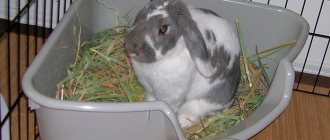Rats are very intelligent animals and can be taught to perform a wide variety of tricks and commands. Therefore, these rodents are easy to train to the tray. This will save a lot of time when it comes to cleaning the cage because it won't have to be done as often. This also saves additional money, since contaminated litter will also not need to be changed every day.
Training equipment
The first thing you will need is one or more trays. The number depends on the size of your cage and the places where rats like to go to the toilet.
However, you don't necessarily need to buy specially made trays from stores - old, clean cardboard boxes cut to size will do, although they will need to be replaced regularly. Plastic food containers will also work for this purpose.
You also need a suitable filler. This should be different from the substrate used on the cage floor and in digging boxes, as rats only need to associate it with the litter box.
Where to put the tray to quickly train a kitten?
The tray is placed in a remote area from the kitten’s feeding area so that the smells do not mix. It is better to choose a corridor, balcony, toilet or bathroom for the cat litter, it depends on the interior and the desires of the owner.
Be sure to read:
The cat cannot go to the toilet in a small way, what to do at home: first aid
It should be easy for the animal to reach the tray at any time of the day without assistance, so it is better to choose a room where there are no doors or where they are easy to open.
You need to immediately determine the only place for the cat’s toilet; you should not rearrange it, as this will negatively affect the kitten’s training in the litter box.
Rat litter
Keep in mind that even the best litter needs to be changed regularly. It is recommended to change the litter in the tray once a day - yes, this is extra work, but your pet will thank you.
The best types of fillers:
- Paper pellet litter:
Paper pellets (such as Carefresh) are an ideal choice for rats as they absorb moisture and are fairly inexpensive. They quickly become soft when they get wet. Therefore, it is worth changing it quite often if you do not want your room to acquire an unpleasant odor.
- Straw pellet litter:
Straw litter works the same as paper litter. This type of litter is also good for rats because it is non-toxic and has excellent absorbent properties. - Shredded cardboard litter:
This type of bedding is good for rats because, like paper pellets and straw litter, cardboard has no harmful properties. - Cloth Bedding
: Some people choose to place cloth in the rat's litter box and clean it daily. This option is suitable if your rat is allergic to other types of litter. However, it is important that the fabric is in good condition. Such material can cause injury if it accidentally wraps around a rat's paws or tail.
However, the following types of fillers should definitely be avoided:
- Cedar and pine litter:
These types of litter should never be used for rat litter because they are extremely toxic. Both of these types of bedding smell great, but produce toxic fumes that can make your rats very sick.
- Cat Litter
: Cat litter, especially lumpy cat litter, can form clumps in a rat's stomach and make them very sick. Also, such bedding often generates copious dust, which is harmful to the respiratory system of rodents. Although, as a last resort, you can choose a natural, non-clumping cat litter. But this is still far from the best choice for a rat. - Cedar Litter:
Another type of litter that is virtually useless for almost any animal. Corn cob litter can cause problems if ingested and tends to become moldy.
How to train a toilet for rats
Rats are very intelligent creatures, so with a little effort they can be taught to perform certain actions. It’s quite simple to accustom a rat to a litter tray, which will ultimately help you save time on cleaning the cage, as well as money on buying litter, because you will need much less of it.
For training we will need the tray itself. You can purchase a special tray for rodents, but in principle, any suitable container with sufficiently high sides (so that rats do not scatter the filler too much) can serve as its role.
Of course, you will also need filler for the tray. The filler should be chosen to be safe, without pine shavings and sawdust. If the tray has a false bottom, you can also use mineral cat litter.
You can train a rat to use a litter tray at any age, but baby rats usually learn easier and faster.
The entire training method is based on the fact that rats by nature are clean creatures and will go to that place, in our case the tray, where they or other rats have already gone, and where a certain smell remains. The entire training procedure can be divided into several stages:
You need to determine a place, usually a corner in the cage, where your rat usually goes to the toilet. Then you need to place a tray with filler there. Nowadays, stores sell many special corner (and other) trays of different sizes, so purchasing a suitable one will not be a problem. You should add a little used litter to the tray so that the rat becomes accustomed to the smell of the toilet. Now, and this is the most important part, remove all the litter from the rest of the cage. Remember that rats can distinguish between the living area and the toilet area, so fill the tray (corn, paper, etc.), and in the rest of the cage you can use waffle towels, mattresses, special diapers for dogs, etc. as bedding. Finally, you need to show the rats their new toilet. Throw them into the cage and place them directly in the tray so they can sniff around. If the rats start going to the tray, you should praise them and give them something tasty as a reward, but if they go to another place, then they should be systematically transferred to the tray and gradually they will understand what you want from them.
As a rule, this method is effective, but it may happen that the rats will not always go to the tray in a small way, especially the males, because they mark their territory. You may also come across a rather stubborn rat that will show its character and refuse to go into the litter box on principle. In this case, be patient and persistent.
The presence of a tray in the cage, as already mentioned, will simplify the cleaning process, because it is much easier to replace the filler in a small tray than in the entire cage, and besides, this can be done as it gets dirty (more often or less often).
A significant advantage in favor of the tray is the fact that the rats will not be in constant contact with the filler. And if you use towels, mattresses or something else as bedding in the rest of the cage, then the rats will feel very comfortable, because this will reduce the presence of possible dust from the filler to zero, and the rat’s paws will always be soft. In addition, in this case there will be less garbage around the cage because the rats will have nothing to scatter.
In the future, during walks, you will need to return the rats to the cage from time to time and put them in the tray so that they understand that they need to go there to the toilet.
Source
Methods for training a rat to use a litter tray
You can train a rat to go to the toilet in a certain place by following the following algorithm:
Step 1:
Find a plastic or cardboard container that can serve as a rat litter tray. Pet stores and pet supply websites now sell trays designed for small rodents. Save money by using a shallow plastic food storage container or an old bowl that will serve the same purpose.
Step 2:
fill the new litter box with new litter, rat droppings and dirty litter. Rat droppings will help the rat understand that this is where it should go to the toilet.
Step 3:
Place the tray in the corner of the cage where the rat most often relieves himself. Most rats are very clean and prefer to only use one area to keep the rest of the cage clean and free of dirt. This makes it very easy to litter box train a rat as they are very tidy animals.
Step 4:
Clean the cage the same day the litter tray is installed in the rat cage. This will rid the space of all previous waste and help the rat understand that only the corner with the tray should be used for elimination.
Step 5:
Place your rat in a special litter tray so he knows it's there. This is especially important if the rat has a very large cage or a cage with several levels. The rat needs to be shown the location of the litter tray; quite possibly many times, especially if the rat does not immediately use the litter tray.
Step 6:
On the first day, check your rat every few hours to make sure it has used the litter box. If you find droppings outside the litter box, simply place the rat and its droppings in the litter box and say, “No!” If you notice your rat using the litter box, reward your pet with his favorite treat.
Training - Basics
If a kitten is only a month old, then at that age it is extremely rare to train it to go to a litter tray without litter.
Veterinarians advise starting the training process with a toilet, which will have something with which the animal can cover its excrement.
The filler can be either pressed wood shavings or mineral lumps of clay, or ordinary newspaper, torn into small fragments.
It is better, of course, to use a tray with a professional filler that can absorb unpleasant odors and liquid feces
Thus, you can quickly accustom any kitten to the tray, street, Scottish or British, it doesn’t matter, the main thing is that its paws and fur will always be clean and dry.
So, the baby is a month old or 1.5 months old, we purchased a tray, found a place for it, now we move directly to the main process.
- Place the tray with the filler in the selected location.
- We carefully lift the kitten and put it in the vessel.
- We take his paws in our hands and begin to make raking movements.
- Let's release the baby.
Don't expect him to do his business in the new toilet the first time.
It often takes several days, and sometimes a couple of weeks, to train one-month-old kittens to use the litter box.
At first, you need to watch your pet and try to catch his desire to go to the toilet.
When a kitten is 1.5 months old, before defecating, it may show some concern: the animal will seem somewhat alarmed, and may spin in place or rake its paws on the floor.
It’s important not to miss the moment when the kitten starts to shit.
Transfer the animal to the litter tray and wait for the baby to do its job
If an outdoor kitten appears in your apartment, then training it to a litter box will be much faster than, for example, an Egyptian Mau or a Burmese cat.
This is due to the fact that an animal that previously lived in street conditions is much more willing to respond to care and at the same time is very smart.
How long will it take in this case? Usually two or three days, no more.
The length of toilet training for your pet may depend on the quality of the litter.
At what age should a kitten be accustomed to a litter box without litter?
You can do this right away, but it is better after he gets used to his toilet and will always defecate exclusively in it.
To consolidate the result, the kitten needs not a month, but much more: about six months must pass for the animal to fully understand where its latrine is, and only after that can one begin to accustom the kitten to a toilet in which there will no longer be litter.
What to do if a rat sleeps or eats in a tray
Don't worry, it happens. It is important to remember that rats do not have human concepts of rooms and hygiene. Yes, they are quite clean animals, they have toilet corners, and in the wild they clean their burrows of dirt. But pooping and peeing still have different meanings for them.
A rat may sleep in a litter tray just because it is convenient for him. Food is often eaten and stored in litter trays because they smell - they mark the territory and food as theirs. And yes, sometimes rats do eat their own waste. This is their way of recycling nutrients.
Reasons for the appearance of rodents in sewers and toilets
Rats decide to live in the same house with you not because it is more convenient and comfortable for them, but because they are forced to look for new places with affordable food and a place to raise offspring . However, these are not the only reasons why rodents decide to move closer to humans. The most common ones are presented below:
- The more actively a rat breeds in the basement, the higher the likelihood that it will soon begin to look for a new place to live, since the old one is filled with its relatives;
- Although rats can tolerate various temperature changes, at the first frost they still try to move to where it will be warmer. In late autumn and winter, rodents increasingly begin to climb into apartments and houses;
- If pest control has recently been carried out in the basement or at a nearby landfill, then be prepared for the fact that entire populations of rats will soon appear in your house, running away from deadly poison.
If the house is old, then it will not be difficult for a rat to gnaw holes in the pipes right in the basement and climb into the apartments. Walls won't stop her either, as a rat's teeth can make a hole in anything. We wrote a separate article about this.
If the house is new, recently rebuilt and made of good and expensive materials, then it will be more difficult for rats to infest it. However, now modern plumbing increasingly consists of ordinary plastic pipes instead of cast iron pipes, which are unlikely to withstand the teeth of rats.
Plastic sewer pipes in the basement are quite vulnerable to rats' teeth
Adviсe
- Separate the litter box in the cage as far away from the sleeping area as possible.
- Clean your rat's litter box at least once a week. Change the litter in the toilet once a week. Refill the litter box with fresh litter as soon as you place him back in the cage. Be sure to clean the bedding weekly to keep your cage odor-free.
- If there is even the slightest odor coming from the litter box, change the litter. Rats have a very sensitive respiratory system, and the smell of ammonia coming from the litter box can cause pneumonia in a rat.
- While you are training your rat, leave some dirty litter or droppings in the litter box so they know where it is.
- Reward your rat with a treat when he uses the litter box to reinforce good behavior. When you notice your rat going about his business in the litter box, praise him in a cheerful voice before giving him a small treat. During the first 2-3 weeks of training, give your rat a treat every time he enters this area of the cage.
- Clean up all droppings outside the litter box at all times. If you see droppings anywhere else in the cage, immediately pick them up and place them in the litter box. Make sure there is no rat waste anywhere, otherwise the training will not be as effective.
There are many benefits to toilet training. This makes the cage much cleaner, reduces odor and means you no longer have to clean the cage as often. If you allow your rat to play outside its cage for a bit, such as in a rat play area, it can also be trained to use the litter box outside the cage. Place the litter box in the same corner of the play area as the cage. If she needs a toilet break while playing, the rat can simply go to the litter box.
How to choose the right litter box for your cat
Cat litter boxes are:
The simplest plastic container
This is a trough, most often rectangular with rounded corners. The troughs are economical, accessible to all segments of the population and are favorably accepted by cats. These trays are pleasing to the eye with a variety of colors and are easy to wash and use. Disadvantage: cannot be used without filler.
Trough-tray with mesh
The same container, only supplemented with a plastic drainage mesh grid, which can be attached either to the sides or inserted inside on legs. The filler is required depending on the wishes, urine easily seeps down, and solid waste remains on the mesh and is easily disposed of.
The disadvantages of a tray with a mesh are that it must be washed after each use; when trying to bury traces of its own vital activity, the cat can catch its claws on the mesh and tip the contents of the tray onto the floor.
Tray with high sides
It justifies itself completely, especially if the pet is large and strong. A tray with removable sides that secure insert bags, which are easy to remove and throw away along with the contents. The additional package includes the same drainage grid as for the trough.
There is only one minus - such a vessel is not suitable for a kitten: the sides are too high.
Tray house
A godsend for shy cats! The house, which looks like a closed carrier, is a real cat bio-toilet, where the cat can quietly retire to perform the desired action. In addition, it eliminates the risk of “inaccurate hits” and prevents the spread of aromas. Disadvantages - to wash, you need to take it apart - one, cumbersome for a cozy corner of “introspection” - two, cats often mistake it for a real house for relaxation - three.
Automatic toilet
This is truly a miracle of engineering genius, providing a carefree life for cat owners. Self-cleaning, wet cleaning, disinfection, no odors, practically no maintenance - a lot of advantages!
The downsides are: special means for maintaining cleanliness, connection to water supply and electricity, noise made when washing, high price. And the biggest drawback is that cats are almost universally afraid of noisy toilets and do not want to shit there. And how to teach a kitten to go to the litter box, pray tell, if he is simply afraid of it?!
No, you need to start toilet training with an ordinary tray - it’s inexpensive, and in the category: “Which tray is better?” it has clear advantages.
Breeds of decorative rats
Let's take a look at the main varieties of pet rats to make it easier for you to choose. Decorative rats are divided into:
Division by body type
rats . The name was given because of its resemblance to Disney's baby elephant Dumbo, who could fly by waving his huge ears. Dumbo the rat's ears aren't that big, but they stand out. Rounded, sticking out more to the sides than to the top, like the others.
What are you watching? Quite an average size!
Standard . There’s nothing even to add to the name of the breed – a standard rat.
Standard? Sounds like an insult.
Tailless . An ordinary house rat, but without a tail.
Classification by coat type
Rex . Pets with beautiful curls.
Rex.
Satin (Satin, Longhair) . Thin, soft fur, which, when properly cared for, shimmers in the rays of light.
Satin Dumbo.
Sphinx (hairless) . Has a little “vegetation” on the head and back. An excellent choice for those who are allergic to wool.
Sphinx Dumbo. Well, aren't I adorable?
Downy (Fuzz) . They are distinguished by short and fine downy fur.
Down jacket.
Types of colors
Nowadays it is difficult to find a color that has not yet been developed by breeders. But there are also those that stand out from the general background.
Blue domestic rat. A very interesting shade of fur that needs to be seen in person (not every screen captures this color correctly).
Husky . The coloring is similar to that of dogs of the same breed.
Decorative white rat. People often look for a white rat with red eyes. The eyes are red because blood vessels are visible through them (in albino rats, not only the fur is discolored, but also the eye pigment).
Choosing a location to install the tray
Before installing the tray in the cage, you need to choose a suitable location. To do this, you will need to carefully monitor your pets for several days. Namely, pay attention to where they relieve themselves. Almost every rat has a favorite place to go to the toilet. Next you will need to perform several sequential steps:
- Place trays in areas where the greatest amount of excrement is observed. In this case, the number of containers should be equal to the number of pets.
- Pour some litter into the toilet. Only different from the main bedding located at the bottom of the cage. After all, the new filler should be associated exclusively with the tray.
- Place a few pieces of rat droppings in containers. The smell of excrement will guide the animal in the right direction.
You should only touch rat feces while wearing rubber gloves. After the procedure, you will need to wash your hands thoroughly with soap.
If your pets go to the toilet erratically and you cannot find suitable places to install the tray, you will need to do the following:
- completely remove the filler from the tray;
- thoroughly wash the cage itself and everything in it, carry out complete disinfection using baking soda;
- cover the bottom with a soft cloth or disposable diaper;
- place the trays in any place and fill them with filler (shredded toilet paper, sawdust, hay).
Since the filler will only be in the toilet container, the animals will have no choice but to use the offered “conveniences”. When the fluffies get used to the trays, you can pour the usual filler into the tray.
Do rats communicate through urine?
It may seem strange (and a little gross), but rats can communicate with each other through urine. Did you know that rats can learn information about other rats, such as age, species, gender, reproductive status, testosterone levels and more, through urine? This is quite remarkable.
They also often mark each other with urine. Female rats are known to mark males they like with their urine. They usually do this before estrus. It is assumed that they do this so they know which males they would like to reproduce before they go into heat.
On the other side of the spectrum, males also mark females. It is believed that they do this without notifying the female that they are available for mating.
Is this possible?
A rat jumping out of a toilet is not a horror story or a fairy tale, but a fairly common occurrence in everyday life. Rats are known to have excellent intelligence, so they are able to guess that a sewer pipe will help them get to a person and settle into his home.
In this way, a wild rat gets into the house most often from residents of the first and second floors , but there are cases when these smart rodents climbed even higher, to the fifth floor. But you ask: “How can rats move through the sewer and not suffocate in the water?” The answer is simple: rats, like all small rodents, can stay at depth for a long time, hold their breath and swim calmly. In apartment buildings, the sewer system is a network of pipes that connect the apartments. A rat can get into them through the basement, swim a little underwater, and then calmly climb up the vertical pipes.
Rats feel safe in the sewer, but in search of food and warmth they can leave it in any way.










